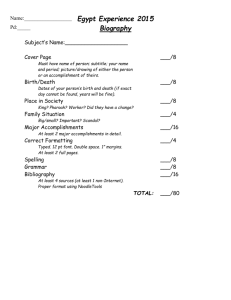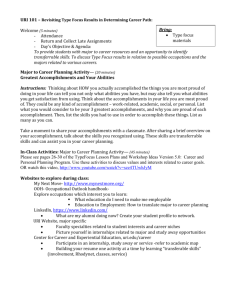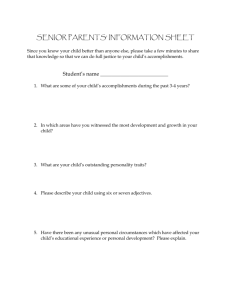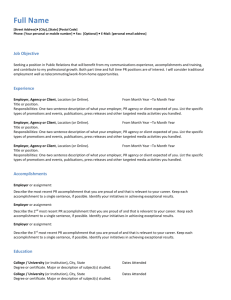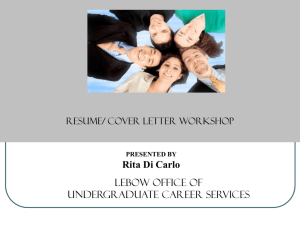Curriculum Vitae Checklist ...
advertisement
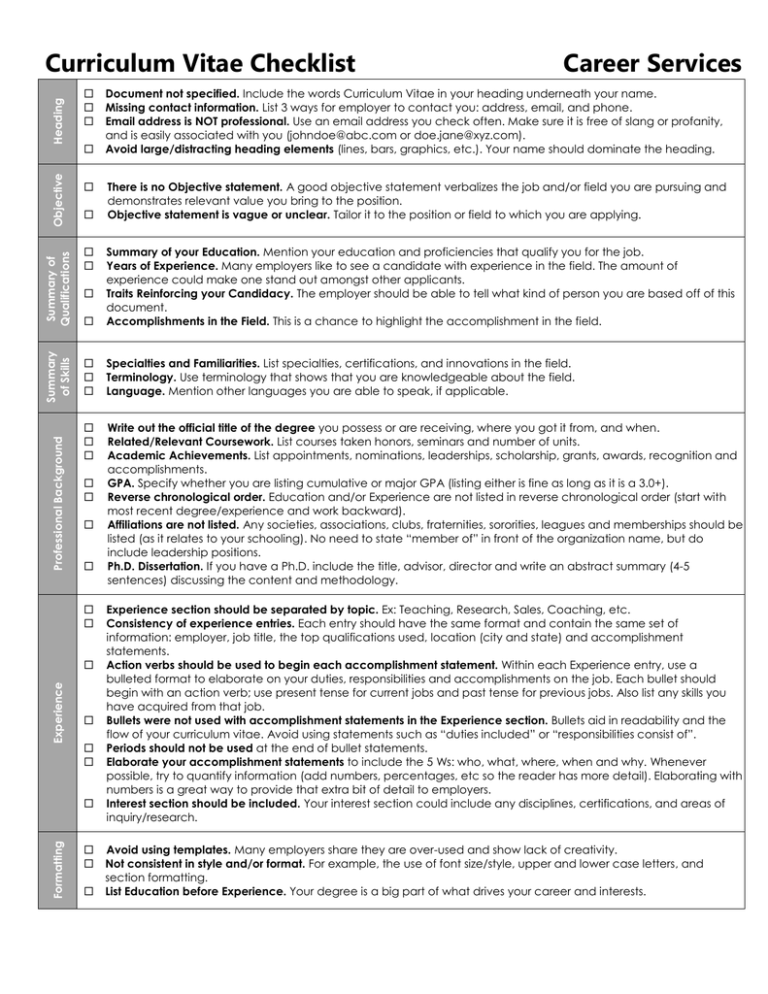
Professional Background Summary of Skills Summary of Qualifications Objective Heading Curriculum Vitae Checklist There is no Objective statement. A good objective statement verbalizes the job and/or field you are pursuing and demonstrates relevant value you bring to the position. Objective statement is vague or unclear. Tailor it to the position or field to which you are applying. Specialties and Familiarities. List specialties, certifications, and innovations in the field. Terminology. Use terminology that shows that you are knowledgeable about the field. Language. Mention other languages you are able to speak, if applicable. Write out the official title of the degree you possess or are receiving, where you got it from, and when. Related/Relevant Coursework. List courses taken honors, seminars and number of units. Academic Achievements. List appointments, nominations, leaderships, scholarship, grants, awards, recognition and accomplishments. GPA. Specify whether you are listing cumulative or major GPA (listing either is fine as long as it is a 3.0+). Reverse chronological order. Education and/or Experience are not listed in reverse chronological order (start with most recent degree/experience and work backward). Affiliations are not listed. Any societies, associations, clubs, fraternities, sororities, leagues and memberships should be listed (as it relates to your schooling). No need to state “member of” in front of the organization name, but do include leadership positions. Ph.D. Dissertation. If you have a Ph.D. include the title, advisor, director and write an abstract summary (4-5 sentences) discussing the content and methodology. Experience Document not specified. Include the words Curriculum Vitae in your heading underneath your name. Missing contact information. List 3 ways for employer to contact you: address, email, and phone. Email address is NOT professional. Use an email address you check often. Make sure it is free of slang or profanity, and is easily associated with you (johndoe@abc.com or doe.jane@xyz.com). Avoid large/distracting heading elements (lines, bars, graphics, etc.). Your name should dominate the heading. Summary of your Education. Mention your education and proficiencies that qualify you for the job. Years of Experience. Many employers like to see a candidate with experience in the field. The amount of experience could make one stand out amongst other applicants. Traits Reinforcing your Candidacy. The employer should be able to tell what kind of person you are based off of this document. Accomplishments in the Field. This is a chance to highlight the accomplishment in the field. Formatting Career Services Experience section should be separated by topic. Ex: Teaching, Research, Sales, Coaching, etc. Consistency of experience entries. Each entry should have the same format and contain the same set of information: employer, job title, the top qualifications used, location (city and state) and accomplishment statements. Action verbs should be used to begin each accomplishment statement. Within each Experience entry, use a bulleted format to elaborate on your duties, responsibilities and accomplishments on the job. Each bullet should begin with an action verb; use present tense for current jobs and past tense for previous jobs. Also list any skills you have acquired from that job. Bullets were not used with accomplishment statements in the Experience section. Bullets aid in readability and the flow of your curriculum vitae. Avoid using statements such as “duties included” or “responsibilities consist of”. Periods should not be used at the end of bullet statements. Elaborate your accomplishment statements to include the 5 Ws: who, what, where, when and why. Whenever possible, try to quantify information (add numbers, percentages, etc so the reader has more detail). Elaborating with numbers is a great way to provide that extra bit of detail to employers. Interest section should be included. Your interest section could include any disciplines, certifications, and areas of inquiry/research. Avoid using templates. Many employers share they are over-used and show lack of creativity. Not consistent in style and/or format. For example, the use of font size/style, upper and lower case letters, and section formatting. List Education before Experience. Your degree is a big part of what drives your career and interests. Other Publications. List all those you are willing to show the search committee. Include work in progress or pending and cite your publications. Presentations and Public Appearances. Include conference papers and research reports. Be sure to state the location and dates. Professional Affiliations should be listed including the society, association, league, position held and dates. Recommendations. Names and contact information of 3-4 references willing to write recommendation letters Spell out acronyms to keep your curriculum vitae looking formal. (ex: Omicron Delta Kappa Honor Society (ODK)) Omit all high school information by your sophomore year of college. From this point, your resume should focus on accomplishments at the college level and beyond. Omit references and/or the unnecessary phrase “references available upon request” on your resume. Provide references on a separate page by request only. Omit information that could cause someone to discriminate against you. (ex: pictures, religious/political affiliations, health condition, marital status, etc.) Spelling and grammatical errors are present. Professional documents can be discarded for just one mistake, make yours error free! Avoid using personal pronouns such as I, me, my and mine. **Attached, you may find additional comments to help you with revisions.
